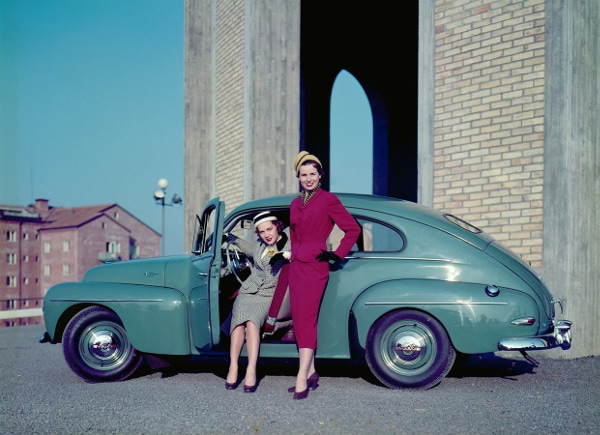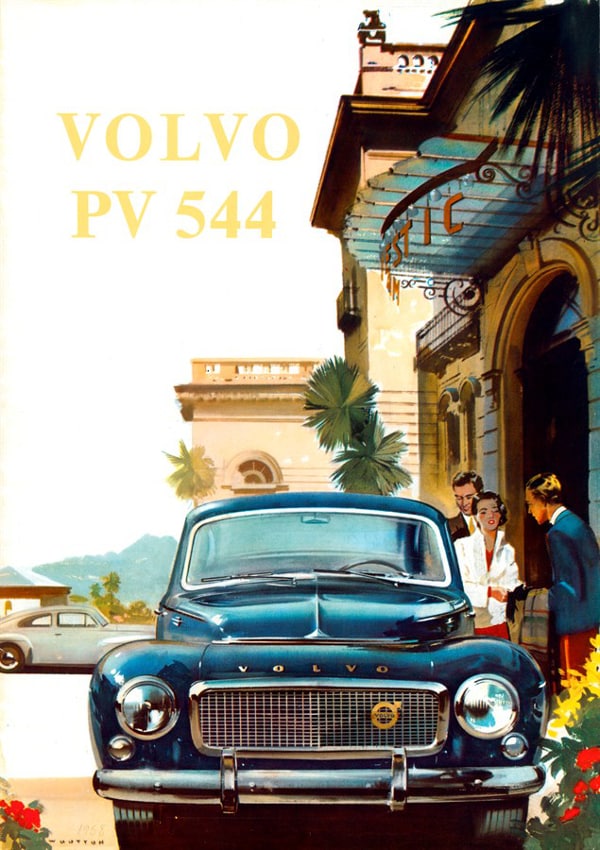
In September 1944, as herald of hope for peace and better times, Volvo presented the PV444 at a large exhibition in Stockholm. The price was a very attractive 4,800 Swedish kronor, the same as what Volvo's first car, the ÖV4, cost in 1927.
The innovative new car was influenced by American styling, and was the first Volvo to feature unibody construction. It was also equipped with a laminated windscreen, an important new safety innovation. Interest in the new model was enormous and the original planned production figure of 8,000 cars became almost 200,000 before the PV444 became the PV544 in 1958. The 444 was the first small Volvo car and the one that really set car production moving at Volvo.
There were 196,005 PV444s produced between 1946-1958. It was a 2-door saloon with an in-line 4-cylinder engine (1,414 or 1,583 cc), producing 40-85 hp. This was fitted to a 3-speed manual transmission, with floor-mounted gear lever. The vehicle also featured hydraulic drum brakes on all wheels.

When the Volvo Amazon was presented in late summer 1956, most people were convinced that the PV, with its rather old-fashioned styling wasn't going to survive much longer. However, the PV with its loyal customer base and healthy sales figures both in Sweden and overseas experienced something of a second wind. On August 25, 1958, Volvo unveiled a thoroughly reworked PV model named the 544.
The combined production run of both the PV444 and PV544 reached almost half a million, far exceeding Volvo economist Assar Gabrielsson’s original estimation of 8,000 cars. The little humpbacked PV was produced in a variety of versions between 1947 and 1965, defying the predictions of many industry observers. All told, the PV was produced in 15 different model series: eight 444 series and seven 544 series. If you were to ask anyone aged over 45 which car model they feel truly symbolises the Volvo brand, the answer, 99 times out of a hundred, will be the PV!
PV544 introduces one-piece windscreen
The basic body-shell of the newly revised PV544 model was identical to that of
the 444 but the big news for the 544 was that the car was designated as a
five-seater, hence the figure "5" in its name, and it featured a large
new one-piece windscreen. The 444 had featured a split windscreen all its life
for repair and insurance reasons, but by 1958 there were virtually no cars left
with such an old-fashioned appearance. The large new windscreen considerably
improved the PV544 and made the car's interior far brighter.
The PV 544 got off to a great PR start on the vital US market in the form of its "sparring partner". During Ingemar Johansson's build-up to challenge the world heavyweight boxing title in the USA in the spring and summer of 1959, Ingo, as he was known, was partnered with another Swedish challenger, a new white PV 544 featuring white tyre sidewalls and the attractive so-called America bars above the bumpers. Ingo's trainer Nisse Blomberg had a dark car with the same specification and drove slowly behind Ingo whenever the boxer was out running. The cars naturally attracted considerable interest and were shown in many newspapers, particularly after Ingo's world-famous right-hand punch on June 25.
Survivor
The PV was relatively cheap to build and, with the help of ongoing technical
development at Volvo, could be kept up-to-date under the skin and even boast
exterior improvements fairly simply and inexpensively. However, the PV was
never fitted with disc brakes - unlike the Amazon. Another technical weakness
that the 544 inherited from the 444 was the doors' exterior handles, which
resembled household door handles and which made the doors rather difficult to
shut and inevitably became troublesome over the years. In most other respects,
however, the model approached perfection.
During the 1960s, the PV 544 lived on in relative anonymity with relatively few production changes every year, but it still had a faithful customer base. That the car was beginning to feel old-fashioned was well-known at Volvo and was a problem for the company, but it was quite simply such a good car! Or, to quote the American motoring magazine Road & Track from November 1963: "Above all the Volvo PV544 is a practical car. Volvo's most attractive appeal lies in its solidity and its quality in every single respect. There is nothing slapdash or under-dimensioned about any part of the car, and that is more than enough to compensate for any perceived lack of glamour."

The only other cars that still continued in production with twenty-year-old
designs were Germany's VW Beetle, and Britain's Morgan. The clock could not be
stopped. The PV544 was presented in August 1965 as a 1966 model and then it was
time to say goodbye. At 3 pm on the afternoon of October 20, 1965, the very
last PV, number 440,000, a specially painted black Sport with red interior trim
- left the assembly line in the Lundby factory. That car can be seen today at
the Volvo Museum. The Amazon now remained the sole standard-bearer of the Volvo
family car range for one year before it was joined - and fairly quickly
dethroned - by the Volvo 144.